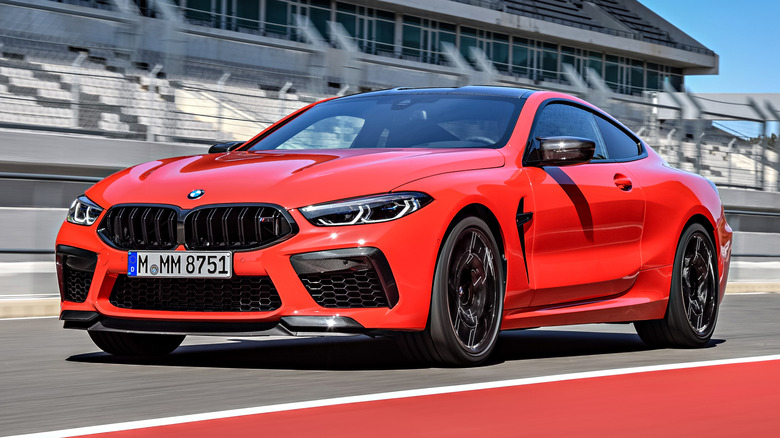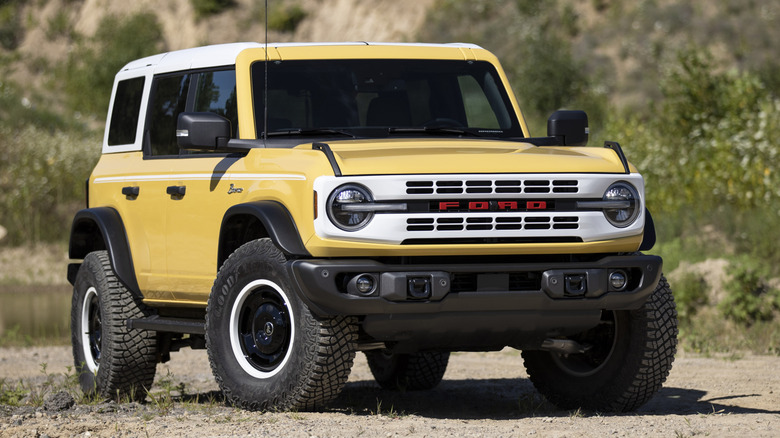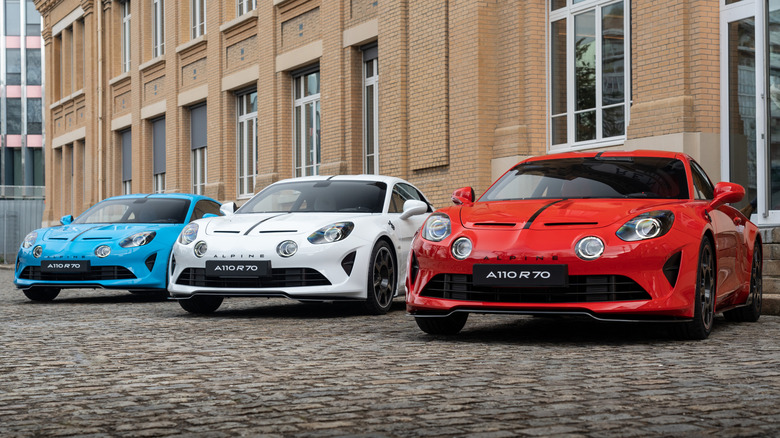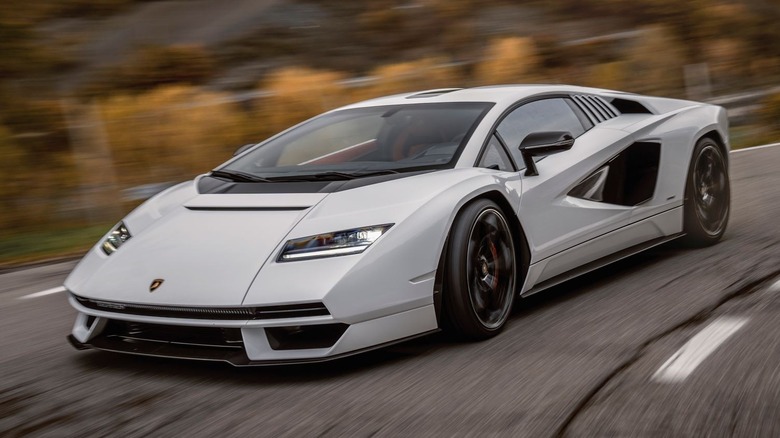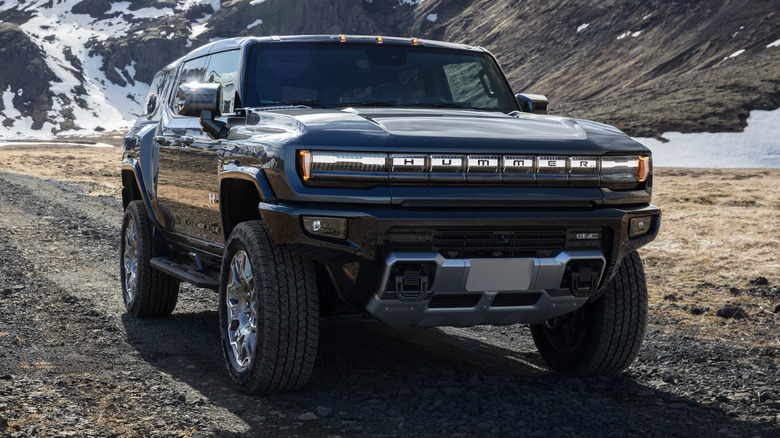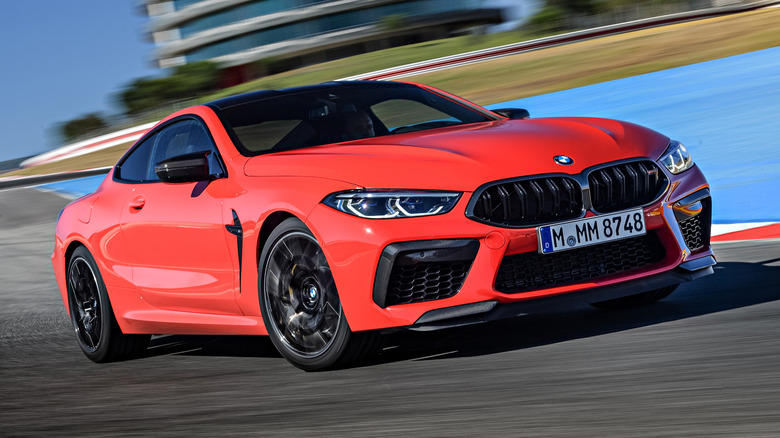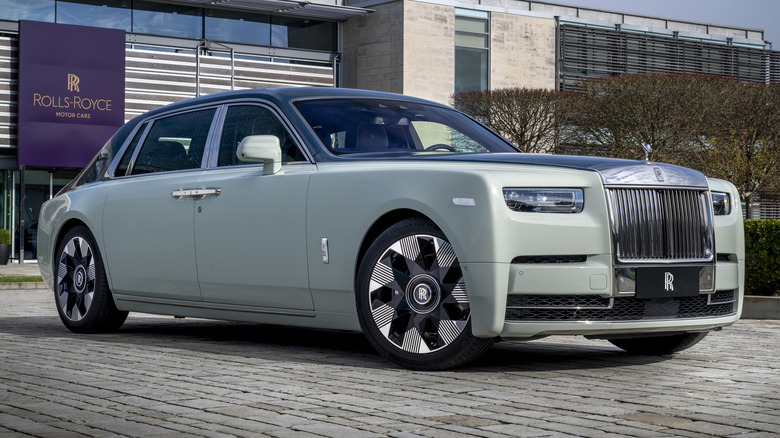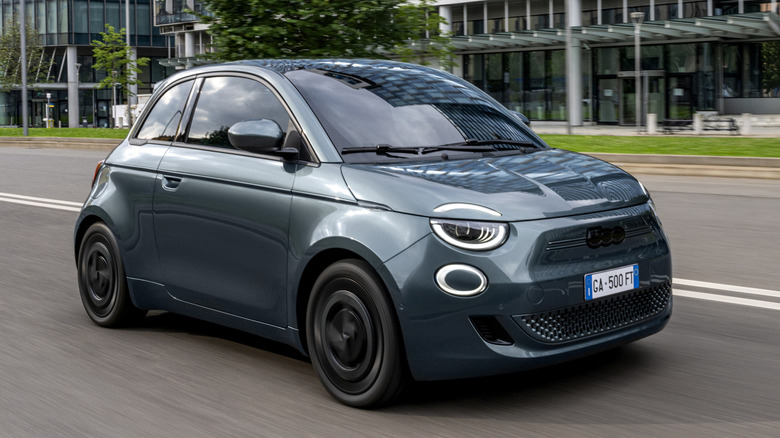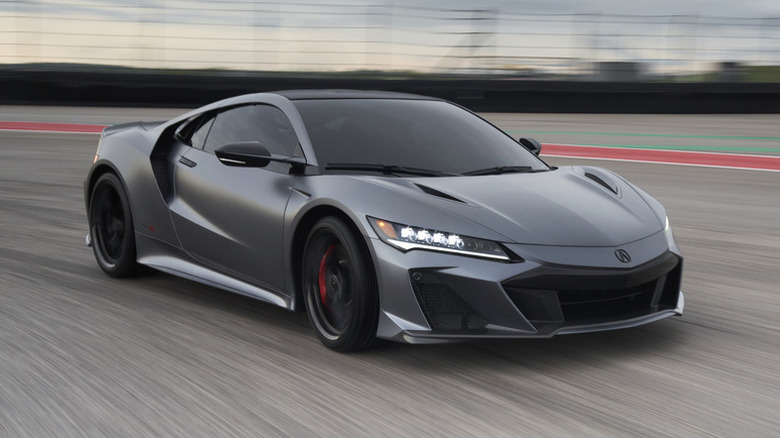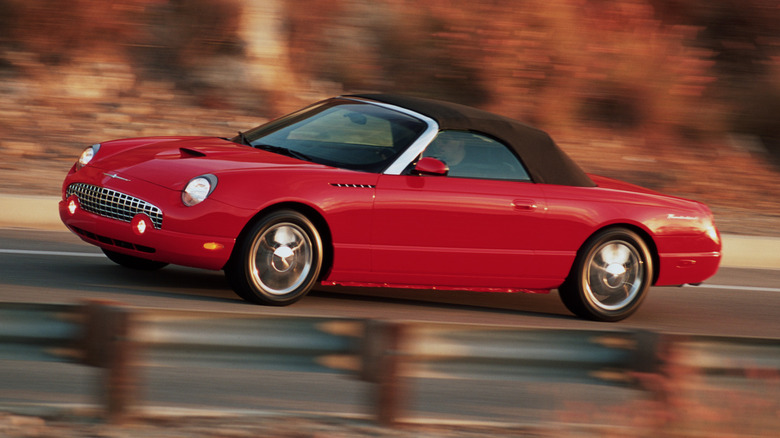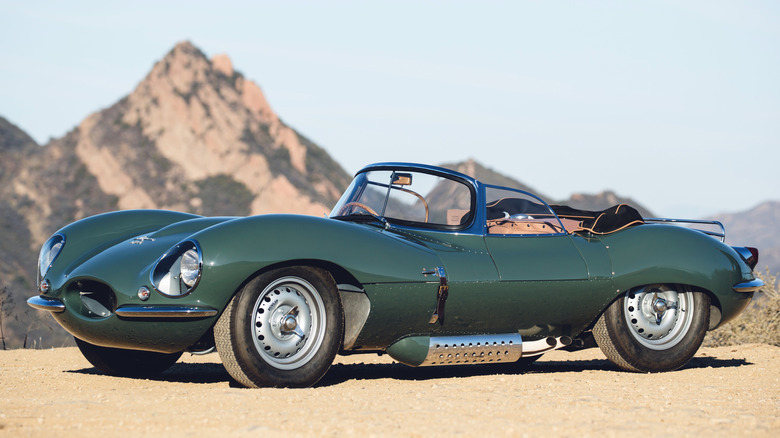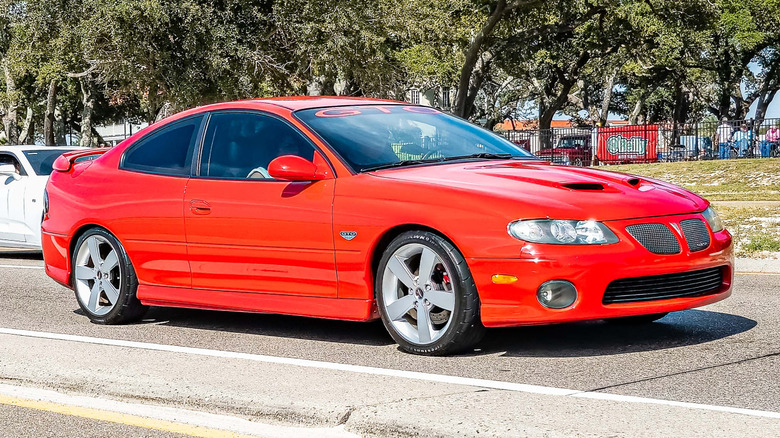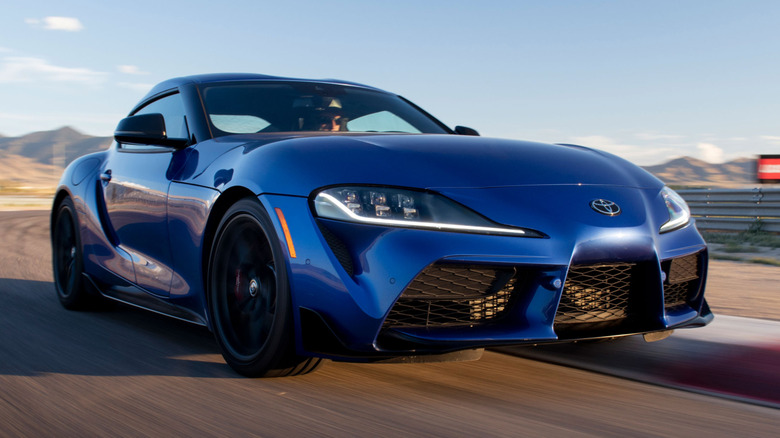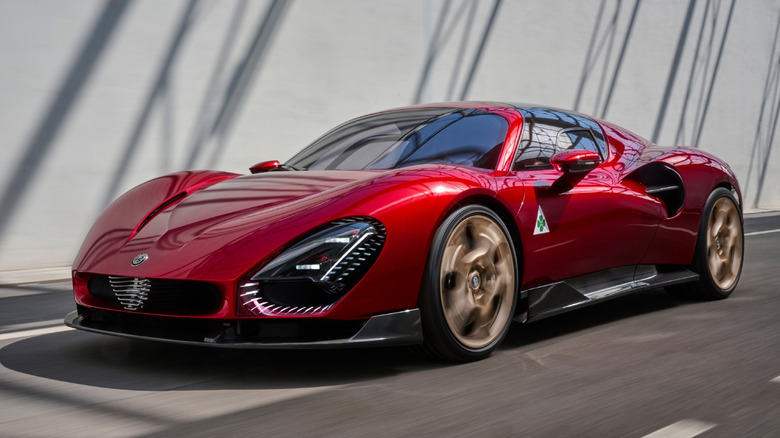14 Discontinued Cars That Came Back From The Dead
Even the most legendary automotive nameplates may face retirement. Some disappear as a result of manufacturer cost cutting, while some are killed off as a result of changing buyer tastes. In a few cases, the manufacturer runs out of cash altogether and declares bankruptcy. However, if there's enough sustained interest from enthusiasts, there's always a chance that these revered cars could be brought back from the dead.
A recent wave of retro nostalgia has seen several formerly dormant nameplates resurrected, and with the upcoming relaunch of the Scout SUV brand, it seems like the trend is set to continue for the foreseeable future. The list of resurrected cars will no doubt continue to increase over time, but for now, we've rounded up a selection of hits and misses from both the past and present. From million-dollar sports cars to classic SUVs, these resurrected names hail from across the automotive spectrum, and many remain available to buyers today.
Ford Bronco
Few recent retro nameplate resurrections have been as successful as the Ford Bronco. Ford leaned heavily into nostalgia for older generations of the car, creating an old-school look and hiding Easter eggs around the vehicle that reference its history. It worked: the Blue Oval sold more than 116,000 examples of the Bronco in 2024 alone, while the model has also racked up strong reviews from outlets, including SlashGear.
It's unlikely that the Bronco would have been such a critical and commercial success had it not channeled the classic SUV so effectively. In Europe, Ford recently brought another retro nameplate back from the dead, its highly regarded Capri sports car. Except the revived model wasn't a sports car, but rather an uninspiring electric crossover. Buyers weren't convinced, and only weeks after production of the car began in Germany, Ford scaled back Capri production and slashed shifts for factory workers.
The Bronco thankfully carries a lot more of the spirit of its predecessors than the Capri, and that's helped it become a major success story for Ford. It remains to be seen where the next-generation Bronco stands in the brand's transition to electric powertrains, but given demand from buyers, it seems likely that Ford won't want to mess with a good thing.
Alpine A110
The A110 name was relaunched in 2016 after decades away from the spotlight. The original '60s car was a rallying legend, winning the first ever WRC event, but its successor is more of an all-rounder. It borrows parts from other Renault Group vehicles, including its engine, but its chassis and suspension were uniquely designed with the help of British sports car maker Caterham. This mix of borrowing parts and designing only the most important bits helped keep costs down, putting it in line with the Porsche Cayman. Unlike the Cayman, the A110's engine has only a 1.8L displacement, but it has been cranked up to provide 300 horsepower.
It isn't available in America, and thanks to the 25-year import rule, it will be a long while before Americans can bring one over. In Europe, the car remains in production for now, although upcoming electrification rules mean that its future is uncertain. Whether it survives or not, the A110 is part of a rare breed of sports car that focuses on driver enjoyment over power figures or technological party tricks, and it deserves to be appreciated while it's still around.
Lamborghini Countach
Brought back as an ultra-limited special edition a full five decades after the original was launched, the 2022 Lamborghini Countach LPI 800-4 borrowed design cues from the original. It didn't, however, borrow its engine design. While the original '70s car had a 4.0L V12 engine and later versions upped that displacement to as much as 5.2L, the 2022 Countach has a hybrid 6.5L V12 powertrain. The combination of combustion and electric power results in a total system output of 803 horsepower.
The resurrected Countach might be a technologically impressive car, and with only 112 examples produced, it's also impressively rare, even by hypercar standards. However, it's arguably not as groundbreaking as the original, which featured bodywork penned by Bertone and outlandish scissor doors that were unique for a production car at the time. Nonetheless, the modern Countach was a hit with wealthy collectors, although it hasn't held its value quite as well as some other ultra-rare hypercars. Examples today cost around $2 million, a notable drop from the reported $2.64 million retail price of the car back in 2022.
GMC Hummer
Given the original Hummer's image as just about the most excessive gas-guzzling SUV available, it's safe to say that it was far from the most likely candidate to receive an all-electric successor. Nonetheless, more than a decade after the original Hummer H1, H2, and H3 were consigned to the archives, the GMC Hummer EV launched in truck and SUV form. Having put it through its paces, we weren't convinced that the latest Hummer's real-world practicality — or rather, lack of it — justified its asking price. There are many other six-figure super-SUVs out there that boast better on-road handling, family hauling capability, and high-end luxury features.
Still, the Hummer's unique selling point is that it doesn't make any sense. Its famous crab walk feature and oversized stature aside, there isn't really anything that makes the Hummer better than other, more mainstream electric SUVs and trucks, but evidently those features alone are enough to seal the deal for plenty of buyers. GMC sold almost 14,000 of these over-the-top off-roaders in 2024, proving there's clearly a sizeable market out there for what's arguably the most nonsensical EV on the market.
BMW 8-Series
Hitting American dealerships for the 1990 model year, the original 8-Series was a high water mark for the brand. It was mechanically groundbreaking, being only the second ever BMW model to feature a V12 engine, and it was visually unprecedented, with a sleeker design than anything else in the brand's lineup at the time. The most desirable variant of the original 8-Series, the 850CSi, is already a sought-after collector's car, with average resale values hovering close to $100,000 today.
The revived 8-Series doesn't have a V12 under its hood, but it does have something that the original never received: an M-badged variant. We spent some time with the current generation M8 Competition Coupe back in 2020 and it grabbed as much attention as many of the most sought-after Italian supercars, particularly with the brightly colored paint scheme of our tester. It's certainly as distinctive, luxurious, and pricey as the original, even if it no longer features the brand's glorious twelve-cylinder engine.
Rolls-Royce Phantom
Rolls-Royce is celebrating the 100th anniversary of the Phantom nameplate in 2025, which was originally coined to distinguish the brand's high-end car from its other supernatural-themed offering, the Silver Ghost. The Phantom was temporarily discontinued during the Second World War, before being brought back as an exclusive model for the British Royal family. This fourth-generation Phantom is the rarest of all, with only 18 examples ever built. The following Phantom V, launched in 1959, was once again made available for public sale, although only the wealthiest businesspeople and heads of state could afford one.
It was replaced after more than a decade on sale by the Phantom VI, which would turn out to be the last generation of the car before its decade-long second discontinuation. According to Rolls-Royce, the last Phantom VI was built in 1993 and delivered to the Sultan of Brunei. The nameplate was then retired, before being brought back to spearhead the brand's 2003 relaunch under BMW ownership.
The Phantom VII was very different to its predecessors, with modern styling and a spaceframe chassis. However, it was still just as opulent as before and proved a hit with buyers. The latest generation of the car, the Phantom VIII, was unveiled in 2017 and remains in production today. Like all Phantoms before it, it doesn't come cheap: prices start north of $500,000 and can stretch far higher with custom commissions.
Fiat 500
When it launched in 1957, the Fiat 500 wasn't immediately popular. At least, not as popular as the 600, its larger and more competitively priced sibling. However, Fiat reworked the car with better equipment, more power, and a lower price, and throughout the '60s, its popularity increased massively. It proved to be the right car at the right time, helping cash-strapped Italians get on the road in style, with its unique styling remaining largely unchanged throughout its production run. By the time the 500 was discontinued in 1975, having been replaced by the 126, over 3.8 million examples of the car had been built.
The 500 nameplate remained dormant for decades until Fiat revived it in 2007. Like the original, the revived car featured the same distinctive styling, a modest powertrain, and a low starting price. Unlike the original, it was a commercial smash hit in Europe straight from launch, with Fiat announcing in 2019 that it had sold over three million examples of the new generation car. However, since the brand controversially axed the gas-powered 500 in favor of the all-electric 500e, demand slumped significantly, leading Fiat to pause production of the car in late 2024. It has since reversed course and plans to relaunch the 500 as a hybrid in late 2025.
Honda/Acura NSX
Honda has discontinued the NSX not once but twice, most recently after 2022. The NSX, which wears an Acura badge in America and a Honda badge everywhere else, caused a storm during its 1989 debut. It handled unlike any other car on the market at the time, boasted the same Japanese reliability as any other Honda, and could be driven at everyday speeds. The first generation was a pioneer not just for Honda, but for the supercar segment as a whole. However, with the Japanese economic bubble bursting, Honda lacked the spare funds to keep developing the car, and by the time it was discontinued, it was no longer the unique, market-beating supercar it once was.
Honda brought the NSX back for a second generation in 2016, again promising a distinctively Japanese take on the supercar. Again, here was a car that was practical, easy to live with, yet fast enough to keep up with European exotica when needed. Much like the original, it never sold very well, and it was given a send-off in 2022 with the launch of the NSX Type S. A new, electric successor is reportedly in the works, and it's set to debut later in the decade. For now, further details remain sparse.
Ford Thunderbird
While many of the relaunched cars here have been broadly successful, the most recent generation of the Thunderbird was more of a mixed bag. The original production run of the Thunderbird came to an end in 1997, when the tenth generation was discontinued. The nameplate then sat unused for a few years until Ford launched a new generation with retro styling and Jaguar underpinnings.
At launch, it generated a lot of attention and decent sales. Critical reviews were also positive, with MotorTrend even naming it the Car of the Year in 2002. In its first year, Ford shifted almost as many Thunderbirds as Chevy did Corvettes, but in 2003, sales figures slumped to around 50% of the previous year's figure. The once-celebratory press also turned on the car, with Car and Driver later calling the Thunderbird one of its "most embarrassing award winners." There was no coming back from such a disastrous slump, and the Thunderbird was axed in 2005.
Jaguar XKSS
A factory fire in 1967 saw nine of the original 25 Jaguar XKSS road cars destroyed. They were not rebuilt, leaving the total production run at 16 cars in 1967. In 2016, Jaguar announced that it was rebuilding the final nine cars with a mix of modern and classic construction methods, with each one designed to be as period correct as possible. Most cars that are brought back from the dead arrive in the form of a new generation with fresh styling and technology, but with the XKSS, Jaguar aimed to make the revived car as close to the original as possible.
The brand even went as far as 3D scanning multiple examples of the original car to account for any inconsistencies between the initial production run, cataloging every single part. By the time the continuation was announced, all nine examples of the new run had been sold for more than $1 million apiece. That might seem like a steep price, but then again, original examples of the XKSS and its race-spec counterpart, the D-Type, have sold for multiple times more at auction.
Pontiac GTO
Although it had all the right ingredients, the last generation of the Pontiac GTO got the recipe just wrong enough to doom it in the eyes of buyers. The car that debuted in 2004 was a resurrection of the legendary muscle nameplate that hadn't been seen since the '70s. Under its hood sat an LS1 V8 engine with 350 horsepower on tap, with both automatic and manual transmission options available. It wasn't the all-American creation its predecessors had been, instead being an Aussie import from GM's Holden division. Down under, it was sold as the Monaro.
Thanks to changing exchange rates in the wake of 9/11, the 2004 GTO also wasn't as cheap as GM had originally intended it to be. It was originally pitched around the same price as a Ford Mustang GT, but it ended up being notably pricier. That price difference, combined with the fact that the GTO was no longer an American muscle car but an Aussie in disguise, was enough to dissuade buyers. The GTO never sold as well as Pontiac hoped, but that didn't stop bosses from launching another Aussie-made successor, the G8, in 2008.
Toyota Supra
It might have caused plenty of controversy because it shared parts with the BMW Z4, but few Toyota enthusiasts could disagree that the return of the Supra was a good thing. Whether in 3.0L, manual transmission guise or with a smaller engine and an automatic 'box, the GR Supra proved to be a solid drivers' car, with the right balance of everyday practicality and track readiness. It also looked the part, with styling that still looks just as striking today as it did when it was unveiled back in 2019.
Few enthusiasts will need an introduction to its predecessor, the legendary MkIV Supra. Its 2JZ engine is, particularly in twin-turbo 2JZ-GTE form, one of the most sought-after tuners' engines around, since it can handle huge amounts of power with only a few upgrades. The old saying of "they don't make them like they used to" rings true here, with few — if any — modern engines aside matching the 2JZ's tuning potential and wide aftermarket.
Even in stock form, the Supra has become a coveted collector's item, with the most pristine examples selling for six-figure sums. In that context, the fifth-generation Supra could never have lived up to the bar set by its forebear, but look past the unreasonably high expectations set by some enthusiasts, and you'll find an enjoyable, competent, and temptingly priced sports car.
Renault 5
The original 5 was a brand-defining car for Renault. It was introduced in 1972 and discontinued in 1985, after the brand had sold over 5.5 million examples. At the peak of its popularity in 1980, it became the second highest-selling car across the globe. Resurrecting the name was a risk, then, but it seems Renault was well aware of that. It has put all of its design and engineering might behind the relaunched 5, and the result is a funky all-electric city car that starts from the equivalent of $31,000 in Europe.
The new 5's electric powertrain is a modest one, with around 150 horsepower in top-spec trims. However, since it weighs 3,200 pounds, that's enough to make the 5 feel zippy for urban jaunts. It's available in a choice of colors, with bright yellow and green among the launch palette. In case it wasn't already French enough, there's also an optional baguette holder hidden in the options list. It's too early to call it a sales success, but the early signs are promising: data from March 2025 shows the 5 as the best-selling EV in France.
Renault has also announced a super-hatch version of the 5, called the 5 Turbo 3E, with rear-wheel drive and 500 horsepower. Despite a price tag stretching comfortably into six-figure territory, the brand has already sold every one of its initial production batch. It plans to cap production at 1,980 examples, with deliveries of the first cars beginning in 2026.
Alfa Romeo 33 Stradale
The original Alfa Romeo 33 Stradale is a multi-million dollar classic race car, and to honor it, the brand launched a multi-million dollar hypercar. Hardly revolutionary, but we still think the Alfa Romeo 33 Stradale is worth its huge price tag. The '60s classic was a road-homologated variant of the brand's successful race car of the same name, with just 18 examples built. The latest version doesn't boast the same racing DNA, but it's just as rare, with production capped at 33 cars.
Unusually for a limited-run hypercar, two entirely distinct powertrains are on offer for the 33 Stradale. One is a traditional combustion powerplant, namely a twin-turbo 3.0L V6, while the other is an all-electric drivetrain. Every example of the car has sold, but Alfa hasn't disclosed how many buyers picked the electric and how many preferred the traditional gas-powered option. It also hasn't disclosed exact pricing, although it's thought to be around $1 million.
